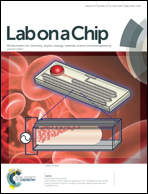3D printed microfluidic devices with integrated versatile and reusable electrodes
Abstract
We report two 3D printed devices that can be used for electrochemical detection. In both cases, the electrode is housed in commercially available, polymer-based fittings so that the various electrode materials (platinum, platinum black, carbon, gold, silver) can be easily added to a threaded receiving port printed on the device; this enables a module-like approach to the experimental design, where the electrodes are removable and can be easily repolished for reuse after exposure to biological samples. The first printed device represents a microfluidic platform with a 500 × 500 μm channel and a threaded receiving port to allow integration of either polyetheretherketone (PEEK) nut-encased glassy carbon or platinum black (Pt-black) electrodes for dopamine and nitric oxide (NO) detection, respectively. The embedded 1 mm glassy carbon electrode had a limit of detection (LOD) of 500 nM for dopamine and a linear response (R2 = 0.99) for concentrations between 25–500 μM. When the glassy carbon electrode was coated with 0.05% Nafion, significant exclusion of nitrite was observed when compared to signal obtained from equimolar injections of dopamine. When using flow injection analysis with a Pt/Pt-black electrode and standards derived from NO gas, a linear correlation (R2 = 0.99) over a wide range of concentrations (7.6–190 μM) was obtained, with the LOD for NO being 1 μM. The second application showcases a 3D printed fluidic device that allows collection of the biologically relevant analyte adenosine triphosphate (ATP) while simultaneously measuring the release stimulus (reduced oxygen concentration). The hypoxic sample (4.8 ± 0.5 ppm oxygen) released 2.4 ± 0.4 times more ATP than the normoxic sample (8.4 ± 0.6 ppm oxygen). Importantly, the results reported here verify the reproducible and transferable nature of using 3D printing as a fabrication technique, as devices and electrodes were moved between labs multiple times during completion of the study.


 Please wait while we load your content...
Please wait while we load your content...